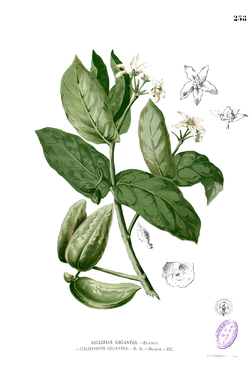Calotropis
| Calotropis | ||
|---|---|---|
 C. gigantea | ||
| Taxonomía | ||
| Dominio: | Eukaryota | |
| Reino: | Plantae | |
| División: | Magnoliophyta | |
| Clase: | Magnoliopsida | |
| Orden: | Gentianales | |
| Familia: | Apocynaceae | |
| Subfamilia: | Asclepiadoideae | |
| Tribu: | Asclepiadeae | |
| Subtribu: | Asclepiadinae | |
| Género: |
Calotropis R.Br. | |
| Especie tipo | ||
|
Calotropis procera[1] (Aiton) W.T.Aiton | ||
| Especies | ||
Ver texto. | ||
| Sinonimia | ||
Calotropis es un género de plantas con 3 especies pertenecientes a la familia Apocynaceae (orden Gentianales). Es originario de las regiones áridas de África y Asia, naturalizada en las zonas tropicales áridas de todo el mundo. Se encuentra en los bordes de caminos, sabanas y lugares abiertos de baja a media altura.[1]
Descripción
[editar]Es un arbusto o pequeño árbol que alcanza hasta los 6 metros de altura. Tiene hojas opuestas y sésiles de color blanco, púrpura o rosa (raramente verdosas o amarillas). Tiene un número de cromosomas de: 2n= 22 (C. gigantea (L.) R.Br., C. procera (Aiton) W.T.Aiton).[1]
Usos
[editar]Se utilizan en la medicina tradicional como hierbas medicinales para tratar las fiebres, reumatismos, indigestiones, resfriados, eccemas, asma, náuseas, vómitos y diarreas. Es utilizado en la medicina Ayurveda y en homeopatía.
Taxonomía
[editar]El género fue descrito por Robert Brown y publicado en Memoirs of the Wernerian Natural History Society 1: 39(preprint). 1810.[3]
Especies
[editar]- Calotropis acia
- Calotropis gigantea
- Calotropis procera
Referencias
[editar]- ↑ a b c d (en inglés) «Calotropis». The Genera of Asclepiadoideae, Secamonoideae and Periplocoideae (Apocynaceae): Descriptions, Illustrations, Identification, and Information Retrieval Universidad de Bayreuth. Consultado el 9 de septiembre de 2009. (enlace roto disponible en Internet Archive; véase el historial, la primera versión y la última).
- ↑ Calotropis en PlantList
- ↑ «Calotropis». Tropicos.org. Missouri Botanical Garden. Consultado el 2 de agosto de 2013.
Enlaces externos
[editar] Wikimedia Commons alberga una categoría multimedia sobre Calotropis.
Wikimedia Commons alberga una categoría multimedia sobre Calotropis.- Imágenes en Google
- (en inglés) USDA classification for Calotropis
- (en inglés) Calotropis procera
- (en inglés) PIER - Calotropis giantea
- (en inglés) Calotropis en uni-bayreuth (enlace roto disponible en Internet Archive; véase el historial, la primera versión y la última).
Text is available under the CC BY-SA 4.0 license; additional terms may apply.
Images, videos and audio are available under their respective licenses.
